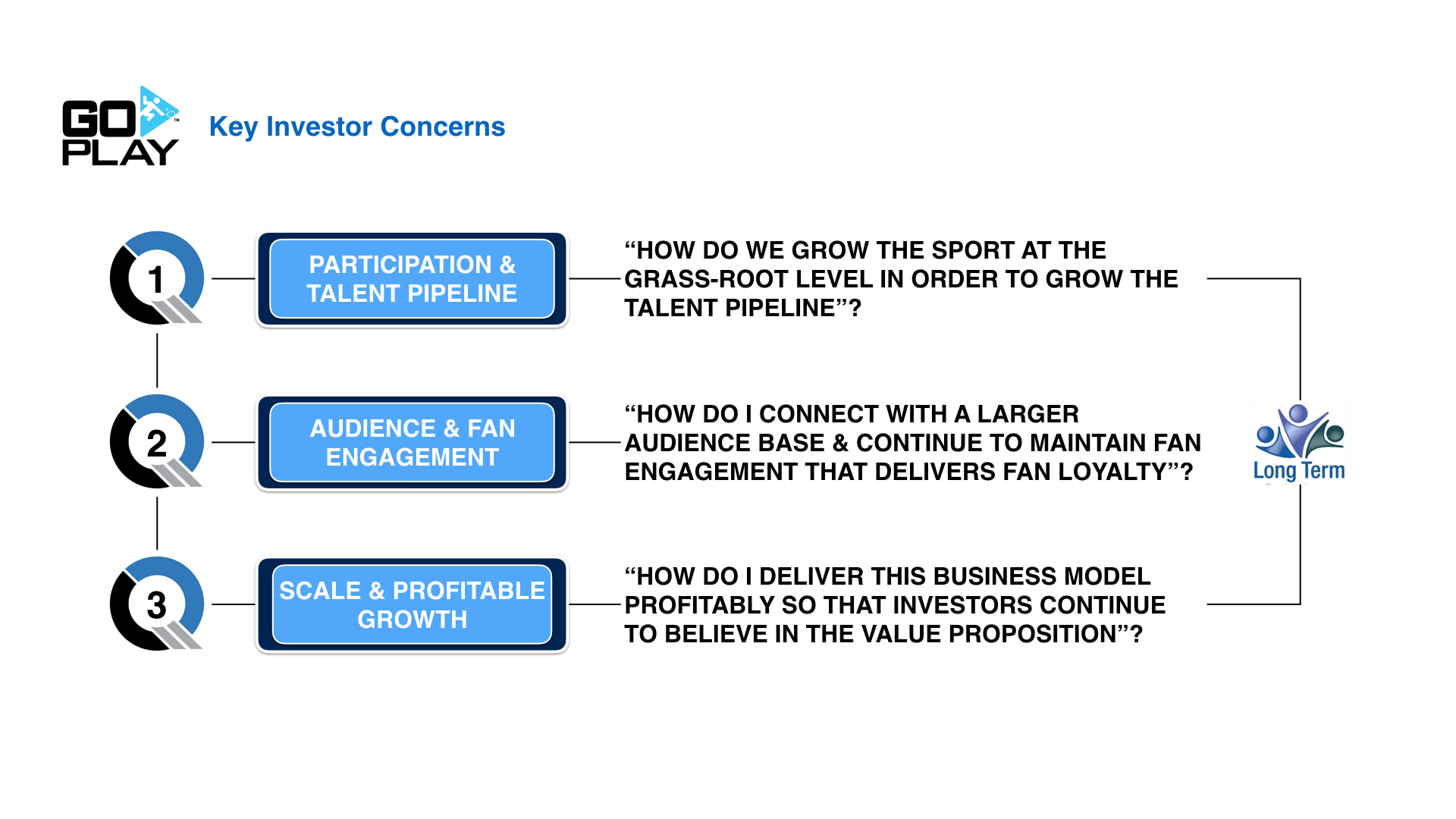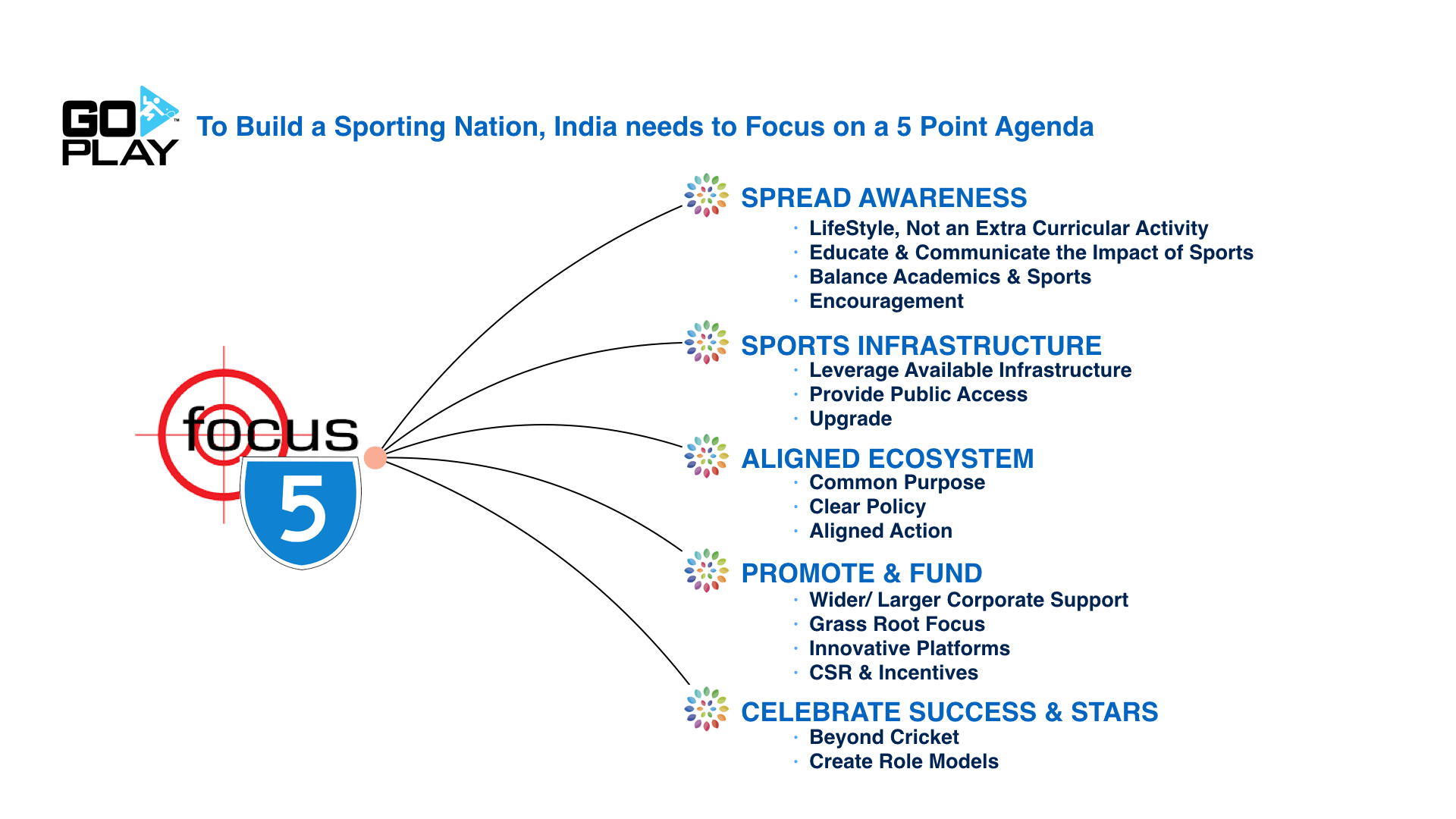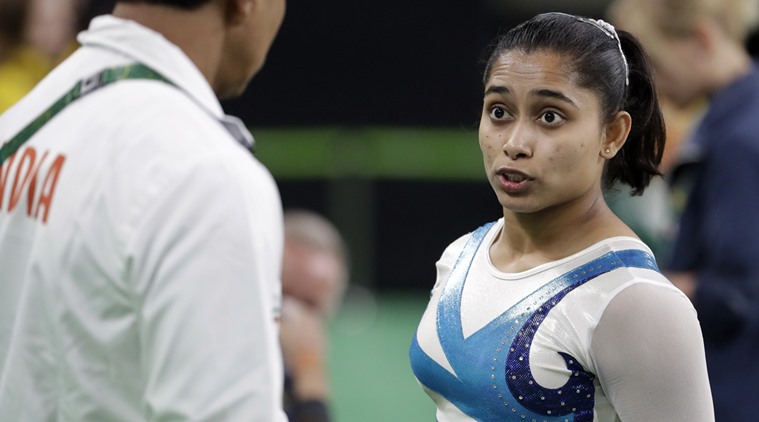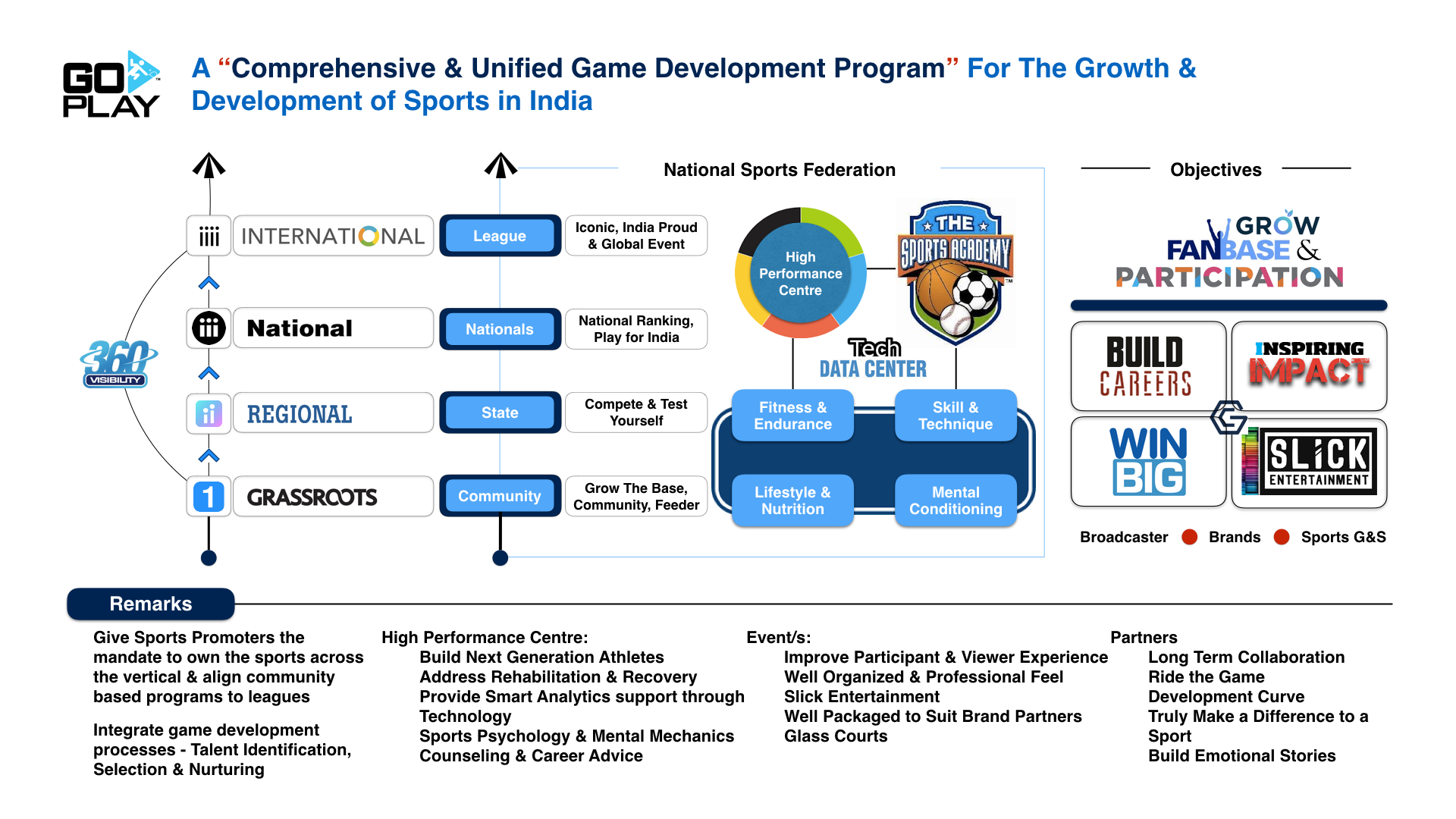Begin typing your search above and press return to search.
Featured
A long term sports development program is what India needs

Sports has the power to heal, build character, resolve differences, unite people and to create cohesiveness unity within a nation. If you add the fact that a little less than half the population of this country falls effectively under the category of "youth", development through physical activity becomes all the more important to ensure a healthy lifestyle. Change through sport creates a deeper granular impact that prepares future generations and helps integrate across people, culture & religious. With this understanding in mind, the Indian Government has initiated a number of policy & program changes to promote sports towards two objectives: - (1) Build Awareness & Participation at the Grass-Root Level (2) Towards Performance Excellence and Podium Finishes

 Why is this the case? As a nation, sports has been a part of our lives since the Vedic ages. If one goes through the pages of the very same epics that the bastions of culture are so proud of holding up in our country, a rich history with intrinsic ties to sport and games emerges. Even in 21st century India, with most talent concentrated at the grassroots, a quick travel to any state will see variations of some very popular, elite sports being played by people of all age and gender. Awareness: The common consensus among parents for not pushing a child into sports is that there seems to be no future if one wants to make it their profession. What gave rise to this impression? Apathy by administrators? Or a lack of awareness when it comes to understanding the importance and relevance of sport on a larger global scale. Either way, this is a problem that should definitely be on the top of the agenda when it comes to rectifying the way sports are dealt with in India. Infrastructure:
Why is this the case? As a nation, sports has been a part of our lives since the Vedic ages. If one goes through the pages of the very same epics that the bastions of culture are so proud of holding up in our country, a rich history with intrinsic ties to sport and games emerges. Even in 21st century India, with most talent concentrated at the grassroots, a quick travel to any state will see variations of some very popular, elite sports being played by people of all age and gender. Awareness: The common consensus among parents for not pushing a child into sports is that there seems to be no future if one wants to make it their profession. What gave rise to this impression? Apathy by administrators? Or a lack of awareness when it comes to understanding the importance and relevance of sport on a larger global scale. Either way, this is a problem that should definitely be on the top of the agenda when it comes to rectifying the way sports are dealt with in India. Infrastructure:  When Dipa Karmakar finished fourth after attempting the Produnova, the vault of death, at the Rio Olympics, the press was filled with stories about how the girl from Tripura had begun her practice in the initial stages on an old scooter due to the lack of a better standard of equipment. You may praise her and romanticise her struggles in the context of the fairy-tale ending she almost got but how fair is it to sportspersons like Dipa and countless other unnamed ones to risk their lives? Why doesn't India have world class infrastructure when it comes to sports? Also Read: Inspired by Dipa Karmakar, India's gymnasts are scripting a path yet unseen in India A success story in this regard may be the TransStadia's Arena- conceptualized by a firm that describes itself as a "a 360 sports company with interests in Sports Infrastructure, Sports Technologies, Sports Academies, Sports Advisory, Intellectual Properties & Rights Management". With the backing of the government, The Arena blossomed into a world class stadium which promise to be a state-of-the-art multi-purpose, multi-sport and social involvement infrastructure in the city of Ahmedabad. A common purpose: A self sufficient ecosystem would see its lower tiers culminating into some sort of a visible change at the more elite level. The investment at the grassroots should show some progress on the upper tiers otherwise, what would be the use. Coming up with a sustainable formula for an ecosystem in a country so vast and varied, that is where the challenge lies. The deepest, most hidden corners of India are where the talent lies. How does one reach those? The Government's flagship scheme, the Khelo India scholarship, despite good intentions may lack in this aspect because it seeks to target elite athletes which fall under the U17 age group. Promote and Fund: Just investing in the sport is never the way out. To reach the maximum one can of the target audience, funding is necessary beyond the sport and its infrastructure. It needs to be sold to the general masses which would then aid in further creating awareness. In relation to this, rewarding star power would go a long way in encouraging more of the masses. This is something the Haryana government has achieved to a great extent which is why the state produces elite athletes regularly across a myriad of sports.
When Dipa Karmakar finished fourth after attempting the Produnova, the vault of death, at the Rio Olympics, the press was filled with stories about how the girl from Tripura had begun her practice in the initial stages on an old scooter due to the lack of a better standard of equipment. You may praise her and romanticise her struggles in the context of the fairy-tale ending she almost got but how fair is it to sportspersons like Dipa and countless other unnamed ones to risk their lives? Why doesn't India have world class infrastructure when it comes to sports? Also Read: Inspired by Dipa Karmakar, India's gymnasts are scripting a path yet unseen in India A success story in this regard may be the TransStadia's Arena- conceptualized by a firm that describes itself as a "a 360 sports company with interests in Sports Infrastructure, Sports Technologies, Sports Academies, Sports Advisory, Intellectual Properties & Rights Management". With the backing of the government, The Arena blossomed into a world class stadium which promise to be a state-of-the-art multi-purpose, multi-sport and social involvement infrastructure in the city of Ahmedabad. A common purpose: A self sufficient ecosystem would see its lower tiers culminating into some sort of a visible change at the more elite level. The investment at the grassroots should show some progress on the upper tiers otherwise, what would be the use. Coming up with a sustainable formula for an ecosystem in a country so vast and varied, that is where the challenge lies. The deepest, most hidden corners of India are where the talent lies. How does one reach those? The Government's flagship scheme, the Khelo India scholarship, despite good intentions may lack in this aspect because it seeks to target elite athletes which fall under the U17 age group. Promote and Fund: Just investing in the sport is never the way out. To reach the maximum one can of the target audience, funding is necessary beyond the sport and its infrastructure. It needs to be sold to the general masses which would then aid in further creating awareness. In relation to this, rewarding star power would go a long way in encouraging more of the masses. This is something the Haryana government has achieved to a great extent which is why the state produces elite athletes regularly across a myriad of sports.
 The culture of making heroes out of sportspersons in the country is an extremely toxic one which often leads the sport into stagnation. Pooling in all your resources to support a single athlete is never the way out. The scopes need to be broadened to see that a sport, any particular sport is taken care of at every possible level. This is why India needs to look at the bigger picture when it comes to developing sports in the country. An athlete centric approach is an extremely negligent one. Rather, if time, effort and monetary resources were put into the aspects described above, we would not only ensure a healthy, flourishing ecosystem but surely keep producing champions for the generations to come. (This article was first published on the author's LinkedIn profile on March 26, 2018.)
The culture of making heroes out of sportspersons in the country is an extremely toxic one which often leads the sport into stagnation. Pooling in all your resources to support a single athlete is never the way out. The scopes need to be broadened to see that a sport, any particular sport is taken care of at every possible level. This is why India needs to look at the bigger picture when it comes to developing sports in the country. An athlete centric approach is an extremely negligent one. Rather, if time, effort and monetary resources were put into the aspects described above, we would not only ensure a healthy, flourishing ecosystem but surely keep producing champions for the generations to come. (This article was first published on the author's LinkedIn profile on March 26, 2018.)
Is Everything right with India's Sports Development Model?
Let's break it down to the main shareholders. The sports industry in India is estimated to grow at a 20% clip over the next decade. Seeing this opportunity, big corporates and entrepreneurs are actively evaluating & investing across the full spectrum - incubating leagues, broadcasting, athlete performance, technology and the support ecosystem. A prime example of this would be the Reliance group. Starting with their tryst with cricket and moving on to the more money oriented Indian Super League, the Reliance development Fund has branched out even deeper within the grassroots of the country. Basketball is a favourite sport. This does not, however, mean that all is right with the sporting ecosystem in India. Whether or not the money being invested is being put to full use is the question. The problems India's sports development suffer from:- Skewed Allocation of funds,
- Limited Grass-root Development Focus & Commercial Viability,
- Unbalanced Media Coverage & Poor Awareness Building Efforts,
- Unsustainable Career Choice &
- Lack of Patience & Long Term Focus
What are the most prominent issues to ponder upon?
Over the last decade, sporting leagues have popped up across Badminton, Hockey, Football, Wrestling, and Kabaddi and many more are planned across other sports such as Athletes, Golf, Boxing, Volleyball and Basketball. However, almost every league is struggling with key fundamental questions that include:How to grow the sport at the grassroot level in order to grow the talent pipeline:
A little example is in order here. As a state, Haryana's culture is deeply intertwined with the sport of wrestling. Every child, earlier it used to be solely male dominated but the situation has significantly improved in the recent past, is coaxed into taking up the sport at a very young age through its very extensive culture of akhadas and dangals. Also Read: Urgent focus needed towards grassroots sports development There is a reason why the state has produced the highest number of competitive wrestlers in the country. Add factors like the target of elite athletes by the state sports policy and the corporate investment done by the Pro Wrestling League, suddenly, Haryana's massive contribution to Indian elite wrestling makes a lot of sense. Several other states like Gujarat have chosen to invest at the grassroots too.
Connecting a larger audience for the sport:
In India, cricket has always seemed to overshadow a lot of other sports which may contain an equally immense amount of talent pool. For the past decades, the sports audience of the country has been fed a steady diet of India's trysts with greatness in the sport. In such a field, breaking out of that mould to usher in something new would definitely take time, precision and effort. That is where the consolidated investment by corporates come in. Perhaps, the biggest example of this can be the Pro Kabaddi League. As an indigenous sport, Kabaddi never made it on to the forefront before the glitz and glamour of the corporate league. In fact, in 2017, the fifth season of the League registered a total of 316 million impressions on Star Sports. By contrast, the India versus Sri Lanka cricket series going on at the time managed to garner just 79 million impressions. In 2017 season, the viewership of the Pro Kabaddi finals (26.2 million viewers) surpassed PV Sindhu's Rio Olympics finals (17.2 million viewers)How to ensure a continued profitable growth:
This is definitely among the key concerns of any investment is to ensure that it is sustainable and yields profits over a longer period time. The success story of the various sports leagues in India might be effective in proving the point. These questions can be addressed in the long term only if India has an -- Agenda for Sports Development
- Adopts a Unified Action Game Development Program
The Pillars of Indian Sports Management
Statistics indicate that India's level of participation in sports is less than 2% of our total population versus the USA & the EU at 32% while Asia Pacific Region is at about 15% of total population. Why is this the case? As a nation, sports has been a part of our lives since the Vedic ages. If one goes through the pages of the very same epics that the bastions of culture are so proud of holding up in our country, a rich history with intrinsic ties to sport and games emerges. Even in 21st century India, with most talent concentrated at the grassroots, a quick travel to any state will see variations of some very popular, elite sports being played by people of all age and gender. Awareness: The common consensus among parents for not pushing a child into sports is that there seems to be no future if one wants to make it their profession. What gave rise to this impression? Apathy by administrators? Or a lack of awareness when it comes to understanding the importance and relevance of sport on a larger global scale. Either way, this is a problem that should definitely be on the top of the agenda when it comes to rectifying the way sports are dealt with in India. Infrastructure:
Why is this the case? As a nation, sports has been a part of our lives since the Vedic ages. If one goes through the pages of the very same epics that the bastions of culture are so proud of holding up in our country, a rich history with intrinsic ties to sport and games emerges. Even in 21st century India, with most talent concentrated at the grassroots, a quick travel to any state will see variations of some very popular, elite sports being played by people of all age and gender. Awareness: The common consensus among parents for not pushing a child into sports is that there seems to be no future if one wants to make it their profession. What gave rise to this impression? Apathy by administrators? Or a lack of awareness when it comes to understanding the importance and relevance of sport on a larger global scale. Either way, this is a problem that should definitely be on the top of the agenda when it comes to rectifying the way sports are dealt with in India. Infrastructure:  When Dipa Karmakar finished fourth after attempting the Produnova, the vault of death, at the Rio Olympics, the press was filled with stories about how the girl from Tripura had begun her practice in the initial stages on an old scooter due to the lack of a better standard of equipment. You may praise her and romanticise her struggles in the context of the fairy-tale ending she almost got but how fair is it to sportspersons like Dipa and countless other unnamed ones to risk their lives? Why doesn't India have world class infrastructure when it comes to sports? Also Read: Inspired by Dipa Karmakar, India's gymnasts are scripting a path yet unseen in India A success story in this regard may be the TransStadia's Arena- conceptualized by a firm that describes itself as a "a 360 sports company with interests in Sports Infrastructure, Sports Technologies, Sports Academies, Sports Advisory, Intellectual Properties & Rights Management". With the backing of the government, The Arena blossomed into a world class stadium which promise to be a state-of-the-art multi-purpose, multi-sport and social involvement infrastructure in the city of Ahmedabad. A common purpose: A self sufficient ecosystem would see its lower tiers culminating into some sort of a visible change at the more elite level. The investment at the grassroots should show some progress on the upper tiers otherwise, what would be the use. Coming up with a sustainable formula for an ecosystem in a country so vast and varied, that is where the challenge lies. The deepest, most hidden corners of India are where the talent lies. How does one reach those? The Government's flagship scheme, the Khelo India scholarship, despite good intentions may lack in this aspect because it seeks to target elite athletes which fall under the U17 age group. Promote and Fund: Just investing in the sport is never the way out. To reach the maximum one can of the target audience, funding is necessary beyond the sport and its infrastructure. It needs to be sold to the general masses which would then aid in further creating awareness. In relation to this, rewarding star power would go a long way in encouraging more of the masses. This is something the Haryana government has achieved to a great extent which is why the state produces elite athletes regularly across a myriad of sports.
When Dipa Karmakar finished fourth after attempting the Produnova, the vault of death, at the Rio Olympics, the press was filled with stories about how the girl from Tripura had begun her practice in the initial stages on an old scooter due to the lack of a better standard of equipment. You may praise her and romanticise her struggles in the context of the fairy-tale ending she almost got but how fair is it to sportspersons like Dipa and countless other unnamed ones to risk their lives? Why doesn't India have world class infrastructure when it comes to sports? Also Read: Inspired by Dipa Karmakar, India's gymnasts are scripting a path yet unseen in India A success story in this regard may be the TransStadia's Arena- conceptualized by a firm that describes itself as a "a 360 sports company with interests in Sports Infrastructure, Sports Technologies, Sports Academies, Sports Advisory, Intellectual Properties & Rights Management". With the backing of the government, The Arena blossomed into a world class stadium which promise to be a state-of-the-art multi-purpose, multi-sport and social involvement infrastructure in the city of Ahmedabad. A common purpose: A self sufficient ecosystem would see its lower tiers culminating into some sort of a visible change at the more elite level. The investment at the grassroots should show some progress on the upper tiers otherwise, what would be the use. Coming up with a sustainable formula for an ecosystem in a country so vast and varied, that is where the challenge lies. The deepest, most hidden corners of India are where the talent lies. How does one reach those? The Government's flagship scheme, the Khelo India scholarship, despite good intentions may lack in this aspect because it seeks to target elite athletes which fall under the U17 age group. Promote and Fund: Just investing in the sport is never the way out. To reach the maximum one can of the target audience, funding is necessary beyond the sport and its infrastructure. It needs to be sold to the general masses which would then aid in further creating awareness. In relation to this, rewarding star power would go a long way in encouraging more of the masses. This is something the Haryana government has achieved to a great extent which is why the state produces elite athletes regularly across a myriad of sports. Unified Action Development Program
Provide Sports Promoters the opportunity to positively impact the development of the sport by integrating efforts across the vertical. The culture of making heroes out of sportspersons in the country is an extremely toxic one which often leads the sport into stagnation. Pooling in all your resources to support a single athlete is never the way out. The scopes need to be broadened to see that a sport, any particular sport is taken care of at every possible level. This is why India needs to look at the bigger picture when it comes to developing sports in the country. An athlete centric approach is an extremely negligent one. Rather, if time, effort and monetary resources were put into the aspects described above, we would not only ensure a healthy, flourishing ecosystem but surely keep producing champions for the generations to come. (This article was first published on the author's LinkedIn profile on March 26, 2018.)
The culture of making heroes out of sportspersons in the country is an extremely toxic one which often leads the sport into stagnation. Pooling in all your resources to support a single athlete is never the way out. The scopes need to be broadened to see that a sport, any particular sport is taken care of at every possible level. This is why India needs to look at the bigger picture when it comes to developing sports in the country. An athlete centric approach is an extremely negligent one. Rather, if time, effort and monetary resources were put into the aspects described above, we would not only ensure a healthy, flourishing ecosystem but surely keep producing champions for the generations to come. (This article was first published on the author's LinkedIn profile on March 26, 2018.)Next Story
